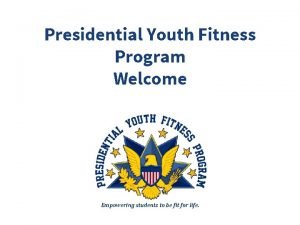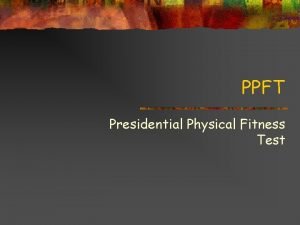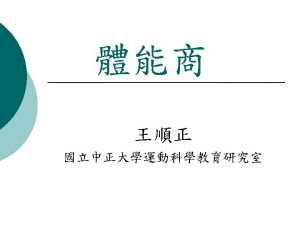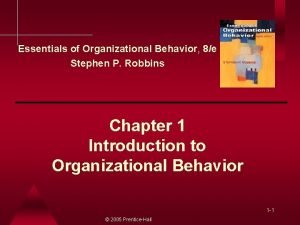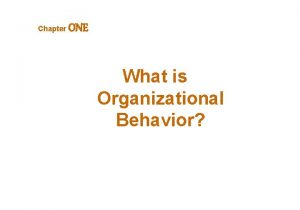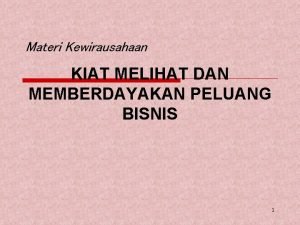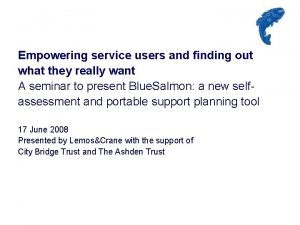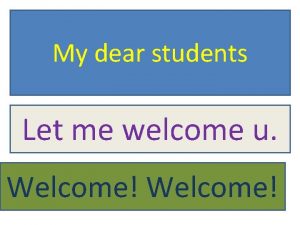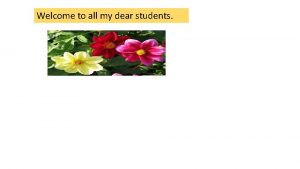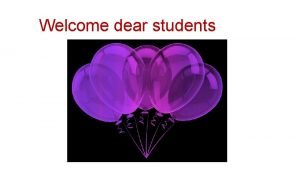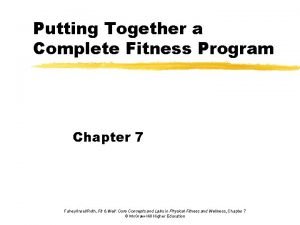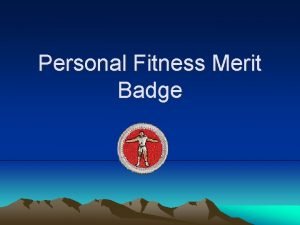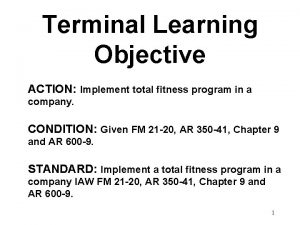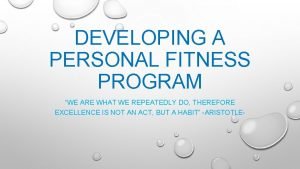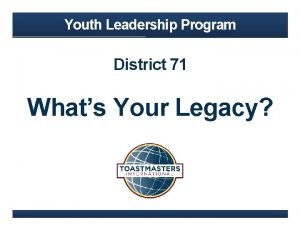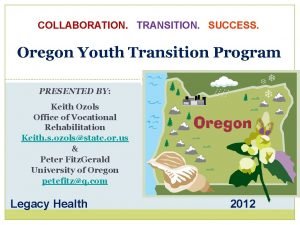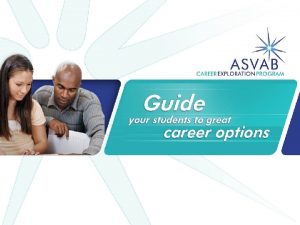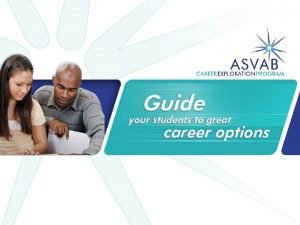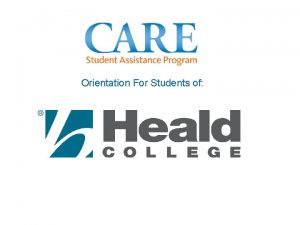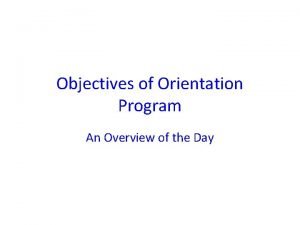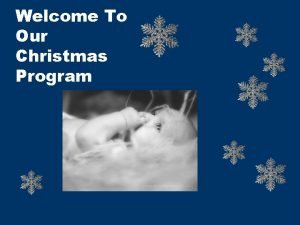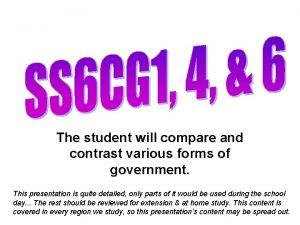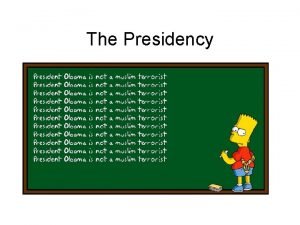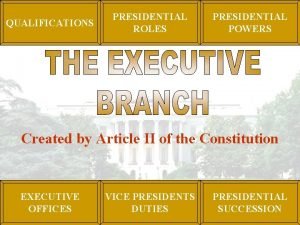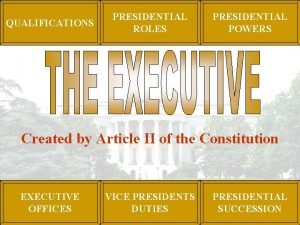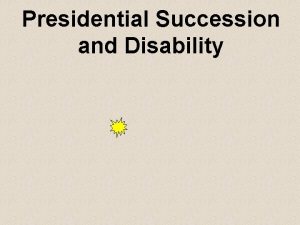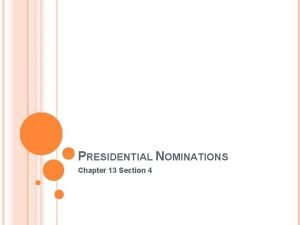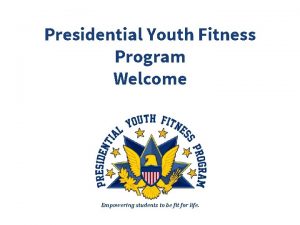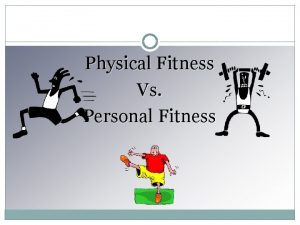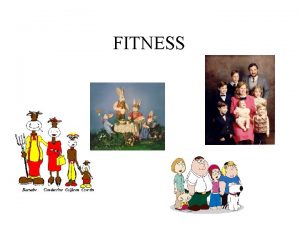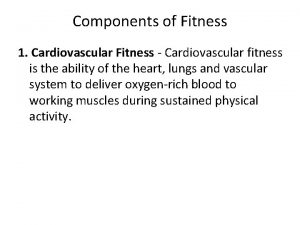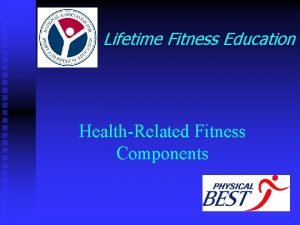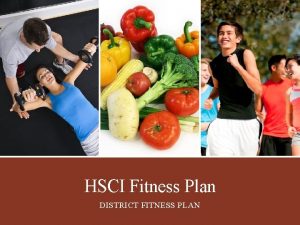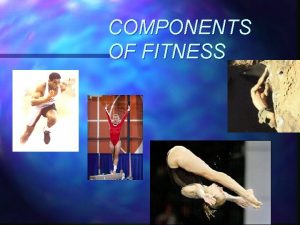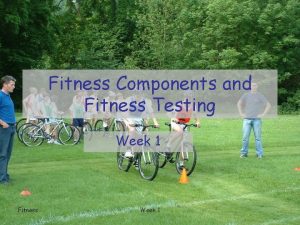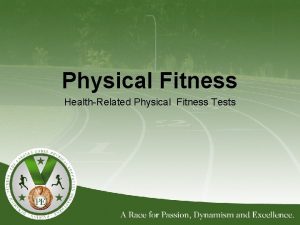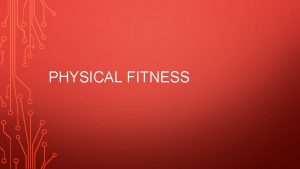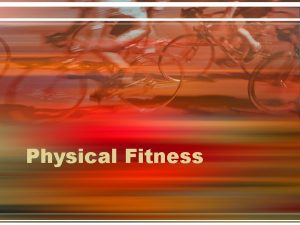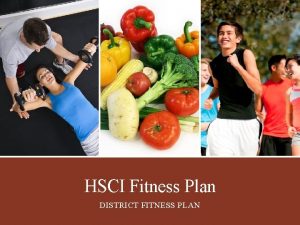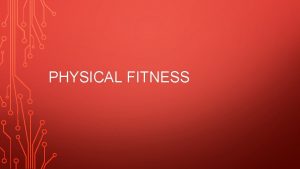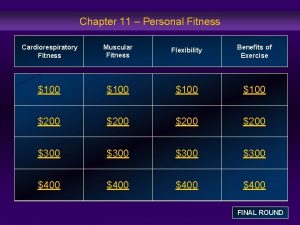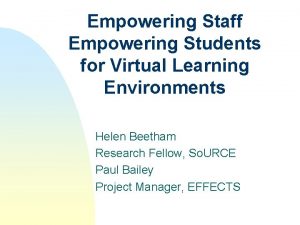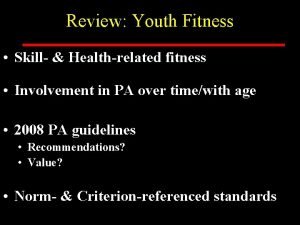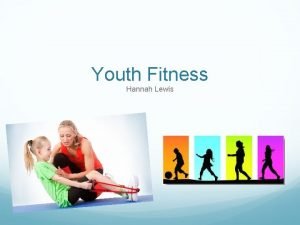Presidential Youth Fitness Program Welcome Empowering students to



























































- Slides: 59

Presidential Youth Fitness Program Welcome Empowering students to be fit for life.

Learning Environment • Group Agreements • Bike Rack • Jar of Jargon

Learning Objectives • Explain the importance of physical activity • Identify national and local initiatives to support PE • Explain why Presidential Youth Fitness Program (PYFP) is important • Identify strategies to implement the PYFP 8 step process of health-related fitness • Identify key resources for implementation of PYFP 3

PYFP Minute to Win It • At your table or in a group of 4, write down everything that you know about the Presidential Youth Fitness Program and /or the 8 Step Fitness Education Process.

Activity Find Someone Who Knows

Find Someone Who Knows… 1. What does PYFP stand for? 2. Name three Fitness. Gram assessments? 3. What does CSPAP stand for? 4. How many minutes of moderate to vigorous physical activity should youth accumulate daily? 5. What does FITT stand for? 6. What are the five health-related fitness components? 8. What does PALA+ stand for? 1. 9. What does LMAS and PAL stand for?

National Guidelines and Data

National Physical Activity Guidelines • 60 minutes Aerobic – Muscle strengthening – Bone strengthening • Age-appropriate • Enjoyable • Variety Physical Activity Guidelines Advisory Committee Report, 2008. Washington, DC: U. S. Department of Health and Human Services; 2008.

Recommendations for School-Based Physical Activity

How Are Schools Doing? • Only 3. 8% of all elementary schools, 7. 9% of all middle schools, and 2. 1% of all high schools provided daily physical education. • 26% of elementary schools did not provide regularly scheduled recess for students in all grades. • Only 43. 6% of elementary schools had students participate in regular physical activity breaks during school. • Only 44. 3% of all schools supported or promoted walking/biking to school. Lee SM, Burgeson C, Fulton JE, Spain CG. Physical education and physical activity: Results from the School Health Policies and Programs Study 2006.

WHY? Children who are more active perform better in the classroom After 20 minutes of Sitting Quietly 3 µV 8 After a 20 minutes of Walking Institute of Medicine of the National Academies. (2013). Educating the Student Body: Taking Physical Activity and Physical Education to School. H. W. Kohl III, & H. D. Cook (Eds. ). Washington DC: The National Academies Press. Image courtesy of Charles Hillman, Professor of Kinesiology and Community Health University of Illinois

Physical Activity During School Physical Education 60 Staff Involvement Minutes Physical Activity Before and After School Family and Community Engagement Comprehensive School Physical Activity Program

Making the Connection National Initiatives National Framework: Comprehensive School Physical Activity Program (CSPAP) National Initiatives: Let’s Move Active Schools (LMAS) Presidential Youth Fitness Program CDC’s State Public Health in Action Plan (1305) Training Mechanisms Physical Activity Leader (PAL) CDC’s CSPAP Guide PYFP Trainings and Webinars SHAPE America Pipeline

National Framework National Initiative Training Mechanism Key Component Training for PE Comprehensive School Physical Activity Program (CSPAP) Let’s Move Active Schools (LMAS) Physical Activity Leader (PAL) Physical Education (PE) Presidential Youth Fitness Program

Essential Components of PE

National Standards The physically literate individual: 1. Demonstrates competency in a variety of motor skills and movement patterns. 2. Applies knowledge of concepts, principles, strategies and tactics related to movement and performance. 3. Demonstrates the knowledge and skills to achieve and maintain a health-enhancing level of physical activity and fitness. 4. Exhibits responsible personal and social behavior that respects self and others. 5. Recognizes the value of physical activity for health, enjoyment, challenge, self-expression, and/or social interaction.

Activity Break

Understanding the PYFP

Mission To provide a model for fitness education that supports teachers and empowers students to adopt an active lifestyle. Empowering students to be fit for life.

What is it? • The national fitness education and assessment program • Free and voluntary • Provides a model to help schools achieve excellence in physical education through quality fitness education and assessment practices • Provides resources and tools for physical educators to enhance fitness education process

Why is it important? • • • Fitness Education should be integrated daily in physical education Helps students solve personal fitness problems now and for a lifetime Healthy Fitness Zones compare students to a level to be healthy not performance Criterion-referenced achievable by majority of students Gives clear and consistent messages to youth

Fitness Test • Either the Mile Run, PACER (20 meter shuttle runs) or the Walk Test (measures aerobic capacity) • Push-ups (measures upper body muscular strength/endurance) • Curl-ups (measures abdominal muscular strength/endurance) • Either the Back Saver Sit and Reach or Shoulder Stretch (measures flexibility) • Trunk Lift (measures trunk extensor strength and flexibility) • Body Mass Index (measures body composition: appropriateness of weight relative to height)

Curl-ups

Pacer Test

Shoulder Stretch

Trunk Lift

Mile Run

Walk Test

Push-ups

Sit and Reach

8 Steps of Health-Related Fitness

Activity: 8 Step Process Movement • Complete the President’s Youth Fitness self- assessment checklist • After completing your checklist; form a group of four and share one technique that you currently use with your group. • As I pass a ball around the room, say your technique and perform a movement to demonstrate your skills.

8 Step Puzzle • Stay with your group of 4 -6 • Open the envelope • Place the health-related fitness steps in order of the 8 step model • Look at the grade bands of steps (K-5, 6 -8, 9 -12) and arrange the puzzle in order (Elementary, Middle, and High School).

8 Step Puzzle Processing 1. Check your answers with the key and make any needed changes. 2. What do you notice about the progression through the grade spans? 3. If a student went through the PYFP Program in grades K-12 at your school or district, what could you see them doing after high school with the knowledge and skills that they attained?

Stepping it Up • Move to the activity area (gym) • Find a friend and walk clockwise • Discuss how you teach fitness education concepts in your classes

Stretch Break When you come back, please bring your notebook with you to the activity area.

Step 1 Fitness Concepts Discuss the fitness concepts with your table.

Step 1: Fitness Concepts Examples Assessment Fitness Concepts Step 1 1. The knowledge 1. Healthbase. What students need to know about fitness to complete/ participate in the other steps. Name the activity components of the Related and Hunt: if it is an aerobic Skill Related component run in place, Exercise Hunt if it is a muscular. Elementary strength or endurance component move your muscles. If it is a 2. Components of flexibility activity Fitness Tabata 2. Discuss in your group how could you increase or WOD the intensity of the (Secondary) WOD for each of the three components? 1. Word Bank Sheet 2. Poster: HRF components 3. Exercise Hunt Task Cards- on for each group of 6 4. WOD/Tabata Workout Task Card-place on walls in 8 places. Interval 20 seconds music, 10 second rest for 2 minutes

Step 2: Student Preparation Examples Assessment Preparatory phase for safe activity and performing activity in and out of school Includes: Why is conditioning important Which activities develop which part of fitness? Why is it important that you warm up and cool down? E. Warm Up Cool E: tell partner four Down Cues 4 Corners components of a warm- up E: 4 corners task cards and cool down S: Tried it, want to Try it, with a friend, not sure task cards S: Activities Inside Warm up cool down cues card and Outside of PE C: choose a new activity to Warm Up try and log activity E: 4 corners task cards S: Tried it, want to Try it, with a friend, not sure task cards Warm up cool down cues card PE letter to parents Activity chart and log

Activity: Jigsaw • Assign group members a number 1 through 6 ✓ Group 1 - read step 2 ✓ Group 2 - read step 3 ✓ Group 3 - read step 4 ✓ Group 4 - read step 5 ✓ Group 5 - read step 6 ✓ Group 6 - read step 7 -8

Activity: Jigsaw • Move to your assigned number around the room. • Read your step and discuss the content as a group. Be prepared to teach your step to the large group. • Practice leading one example and the assessment using the resources provided. • Teach your step to the large group. • Process out with the large group.

Step 3: Practice Procedures Examples Assessment Fitness Concepts Step 1 1. K-3 PYFP Opportunity for students to learn about fitness S assessments and PRACTICE prior to assessing Includes: Why the test is important What the test measures How to properly perform the assessment. Fitness Club Cues 1. Secondary Soccer Skill PACER E: Teacher Observation S: Exit slip PACER protocol ( Write down the directions of how to do the PACER correctly to a new student and tell them what do you do when you miss two times. ) Resources 1. PYFP Fitness Club Cues 2. Fitness. Gram Videos 3. Testing Tips 4. Station cards for Fitness. Gram 5. Fitness. Gram music CD and music system

Step 4: Assessment Examples Assessment Fitness Concepts Step 1 E. Creating a Actual assessment is administered and student is able to perform all fitness assessments following the assessment protocols. Includes: Understanding the difference between the different types of fitness assessments (self assessment, peer assessment, institutionalized testing, physical best testing, etc. ) Analyze Results Students understand/analyze/interpret what their individual fitness scores mean. Includes: Ability to determine whether or not they are in the healthy fitness zone. E. Score Cards S: Peer Check positive Teacher environment Observation for Institutional Testing S: Peer Check and Interpreting Results Resources FG station cards Peer checklist Score card Cones Tips for Success Sheet FG Trunk Lift Ruler

Step 5: Goal Setting/ Program Planning Examples Assessment Fitness Concepts Step 1 E : Goal Setting Students are able to use their individual fitness scores to set goals for personal growth and improvement. Program Planning How to create a personal plan, including the principles of training –frequency, intensity, time, type, specificity, progression, overload. Activities students can do by themselves at home or in the community. Setting S: Perform and Plan Activity for Home Activity Scoring Rubric Goal setting activity plan Goal setting Elem and Secondary Example Tips for goal setting sheet Ways to log pa guide Calendar

Examples Assessment Fitness Concepts Step 1 Step 6: Promoting Tracking Record or log physical activity tied to their personal plan. Provide time during PE, recess, leisure time to participate in fun activities to achieve their personal plan/goals. Process: PALA+ Track It Activity 8 week tracking log and awards Document tracking choice PALA+ Tracking Examples

Step 7/8: Reassessment and Refining Goals Examples Assessment Resources Reassessment Re-do fitness assessment periodically so students can see progress Recognize successes, improvements and achievement of goals. Show individual progress and group progress using reports Use the reassessment to revise goals, instruction (process starts over) Inform students of progress or lack thereof Empower students to take charge of their future assessments, goals and plans to improve physical activity behavior patterns. Personal Best Days Self Test Stations Case Study Summer Activity Plan Personal Responsibility Rubric Group Project Station Cards Rubric Short term and long term goal setting guide Case study Fitness Concepts Step 1

Stretch Break

Moving Forward with PYFP

PYFP Resourses • Use the Checklist to guide your instruction • Use data to guide curricular changes in program • Read professional development materials at pyfp. org • Assess your students at all levels of the 8 Steps • Recognize your students and school • Enroll your school in LMAS

Inappropriate Uses of Fitness. Gram Student fitness assessment results/scores are not: • Used to assign a physical education grade • Used to evaluate teacher performance • Posted publicly nor shared except when in aggregate form and/or when confidentially communicated with student and/or parents.

Review Health Related Fitness Education Process • Return to your jigsaw groups • What can you implement in your classes now • Write on a sticky what you currently implement in the 8 step process or now have the ability to implement based on the information you learned today • Group Discussion

Action Plan • Write on your action plan what you will do in 30 , 60, 90 days to continue to implement PYFP • Resources to reach action plan/goals

3 Takeaways • PYFP Checklist/8 Step Process • How/where to get started • CSPAP Framework

Resources STEP 1 STEP 2 • Elementary Fitness. Gram Activity Hunt Lesson • My MVPA Physical Activity Log • Secondary Fitness. Gram WOD Lesson • Elementary Warm-up • Fitness Concept Cards • Secondary Lesson

Resources STEP 3 STEP 4 • Exit Slips • Fitness. Gram Handout • K-3 Info Sheet • Fitness. Gram Scoring Sheets • Peer Observation Check list • HFZ Standards • Personal Fitness Records • Fitness. Gram Cards

Resources STEP 5 STEP 6 • Exercising at Home Worksheet • Personal Best Day Sheets • FITNESSGRAM Goal Setting • Funtervals • Hellison’s Developmental Levels • Darebee Workout Cards • Super Tracker

Resources STEP 7 & 8 • Short-Term Goals Versus Long-Term Goals • BMI Measurement In Schools • Personal Fitness Plan

Resources • Puzzle • PYFP Check List • Health Related Fitness Education Process • Grade Level Outcomes • Secondary Fitness Test Sheet • The Essential Components of Physical Education • Activity Breaks • Health and Academic Achievement • Mission Impossible Game

Let’s Get Moving! Contacts Nathan Burgess: Ell-Saline Elementary nburgess@ellsaline. org Andrew Cherry: Ellinwood Grade School acherry@usd 355. org Elyse Espinoza: Hocker Grove Middle School elysemespinoza@smsd. org Jayme Lindstrom: Washburn Rural Middle School lindsjay@usd 437. net Tiffany Lippoldt: Skelly Elementary tjlippoldt@eldoradoschools. org Libbie Stover: Seitz Elementary libbiestover@gmail. com Candee Stuchlik: Wichita Heights High cstuchlik@usd 259. net Brandon Wolff: Maize South Middle School bwolff@usd 266. com
 Presidential youth fitness program score sheets
Presidential youth fitness program score sheets Quotes about empowering youth
Quotes about empowering youth Youth empowerment in the philippines
Youth empowerment in the philippines Ppft meaning in physical education
Ppft meaning in physical education Skill related fitness vs health related fitness
Skill related fitness vs health related fitness Aahper youth fitness test
Aahper youth fitness test Empowering people in ob
Empowering people in ob Empowering people in ob
Empowering people in ob Empowering people in ob
Empowering people in ob Empowering and delegating
Empowering and delegating Acer empowering people
Acer empowering people Empowering minds curriculum
Empowering minds curriculum Bagaimana pemberdayaan peluang usaha yang baik
Bagaimana pemberdayaan peluang usaha yang baik Empowering imagination
Empowering imagination Social work: an empowering profession 9th edition chapter 1
Social work: an empowering profession 9th edition chapter 1 Objective of delegation
Objective of delegation Empowering service users
Empowering service users Empowering writers expository
Empowering writers expository Monetizing energy data
Monetizing energy data Empowering imagination
Empowering imagination What image did rizal carved on a piece of batikuling
What image did rizal carved on a piece of batikuling Welcome canada amount for international students
Welcome canada amount for international students Welcome back my dear students
Welcome back my dear students My dear students
My dear students Let me welcome you
Let me welcome you Welcome my dear students
Welcome my dear students Picnic with friends email
Picnic with friends email Welcome my dear students
Welcome my dear students Welcome my dear students
Welcome my dear students Welcome dear students
Welcome dear students Wise men three clever are we
Wise men three clever are we Complete fitness program
Complete fitness program Merit badge personal fitness
Merit badge personal fitness Objective of fitness program
Objective of fitness program My personal fitness plan
My personal fitness plan Wioa youth program elements
Wioa youth program elements District 71 toastmasters
District 71 toastmasters Red cross youth
Red cross youth Ytp oregon
Ytp oregon Asvabprogram access code
Asvabprogram access code Asvab career exploration program for high school students
Asvab career exploration program for high school students Orientation objectives
Orientation objectives Gifted education curriculum in the philippines
Gifted education curriculum in the philippines Career orientation for high school students
Career orientation for high school students Objectives of orientation programme for teachers
Objectives of orientation programme for teachers Welcome for christmas program
Welcome for christmas program Welcome to our christmas program
Welcome to our christmas program Welcome program
Welcome program Todays sabbath school lesson
Todays sabbath school lesson President help wanted poster
President help wanted poster Definition of presidential form of government
Definition of presidential form of government Unitary state
Unitary state Presidency line of succession
Presidency line of succession Informal presidential powers
Informal presidential powers President formal and informal powers
President formal and informal powers Chief agenda setter examples
Chief agenda setter examples Presidential roles
Presidential roles Presidential succession
Presidential succession Presidential succession
Presidential succession Chapter 13 section 4 presidential nominations
Chapter 13 section 4 presidential nominations
